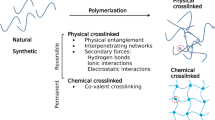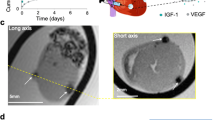Abstract
The material properties of myocardium are an important determinant of global left ventricular function. Myocardial infarction results in a series of maladaptive geometric alterations which lead to increased stress and risk of heart failure. In vivo studies have demonstrated that material injection can mitigate these changes. More importantly, the material properties of these injectates can be tuned to minimize wall thinning and ventricular dilation. The current investigation combines experimental data and finite element modeling to correlate how injectate mechanics and volume influence myocardial wall stress. Experimentally, mechanics were characterized with biaxial testing and injected hydrogel volumes were measured with magnetic resonance imaging. Injection of hyaluronic acid hydrogel increased the stiffness of the myocardium/hydrogel composite region in an anisotropic manner, significantly increasing the modulus in the longitudinal direction compared to control myocardium. Increased stiffness, in combination with increased volume from hydrogel injection, reduced the global average fiber stress by ~14% and the transmural average by ~26% in the simulations. Additionally, stiffening in an anisotropic manner enhanced the influence of hydrogel treatment in decreasing stress. Overall, this work provides insight on how injectable biomaterials can be used to attenuate wall stress and provides tools to further optimize material properties for therapeutic applications.







Similar content being viewed by others
References
Avants, B. B., N. J. Tustison, J. Wu, P. A. Cook, and J. C. Gee. An open source multivariate framework for n-tissue segmentation with evaluation on public data. Neuroinformatics 9(4):381–400, 2011.
Burdick, J. A., C. Chung, X. Jia, M. A. Randolph, and R. Langer. Controlled degradation and mechanical behavior of photopolymerized hyaluronic acid networks. Biomacromolecules 6(1):386–391, 2005.
Dang, A. B., J. M. Guccione, J. M. Mishell, P. Zhang, A. W. Wallace, R. C. Gorman, J. H. Gorman, III, and M. B. Ratcliffe. Akinetic myocardial infarcts must contain contracting myocytes: finite-element model study. Am. J. Physiol. Heart Circ. Physiol. 288(4):H1844–H1850, 2005.
Demer, L. L., and F. C. Yin. Passive biaxial mechanical properties of isolated canine myocardium. J. Physiol. 339:615–630, 1983.
Dobaczewski, M., C. Gonzalez-Quesada, and N. G. Frangogiannis. The extracellular matrix as a modulator of the inflammatory and reparative response following myocardial infarction. J. Mol. Cell. Cardiol. 48(3):504–511, 2010.
Dvir, T., A. Kedem, E. Ruvinov, O. Levy, I. Freeman, N. Landa, R. Holbova, M. S. Feinberg, S. Dror, Y. Etzion, J. Leor, and S. Cohen. Prevascularization of cardiac patch on the omentum improves its therapeutic outcome. Proc. Natl. Acad. Sci. USA 106(35):14990–14995, 2009.
Engelmayr, Jr., G. C., M. Cheng, C. J. Bettinger, J. T. Borenstein, R. Langer, and L. E. Freed. Accordion-like honeycombs for tissue engineering of cardiac anisotropy. Nat. Mater. 7(12):1003–1010, 2008.
Epstein, F. H., Z. Yang, W. D. Gilson, S. S. Berr, C. M. Kramer, and B. A. French. Mr tagging early after myocardial infarction in mice demonstrates contractile dysfunction in adjacent and remote regions. Magn. Reson. Med. 48(2):399–403, 2002.
Fomovsky, G. M., J. R. Macadangdang, G. Ailawadi, and J. W. Holmes. Model-based design of mechanical therapies for myocardial infarction. J. Cardiovasc. Transl. Res. 4(1):82–91, 2011.
Guccione, J. M., A. D. McCulloch, and L. K. Waldman. Passive material properties of intact ventricular myocardium determined from a cylindrical model. J. Biomech. Eng. 113(1):42–55, 1991.
Gupta, V., and K. J. Grande-Allen. Effects of static and cyclic loading in regulating extracellular matrix synthesis by cardiovascular cells. Cardiovasc. Res. 72(3):375–383, 2006.
Holmes, J. W., T. K. Borg, and J. W. Covell. Structure and mechanics of healing myocardial infarcts. Annu. Rev. Biomed. Eng. 7:223–253, 2005.
Ifkovits, J. L., E. Tous, M. Minakawa, M. Morita, J. D. Robb, K. J. Koomalsingh, J. H. Gorman, 3rd, R. C. Gorman, and J. A. Burdick. Injectable hydrogel properties influence infarct expansion and extent of postinfarction left ventricular remodeling in an ovine model. Proc. Natl. Acad. Sci. USA 107(25):11507–11512, 2010.
Jacobs, N. T., D. Cortes, S. E. Szczesny, E. J. Vresilovic, and D. M. Elliott. Effect of boundary conditions on stress-strain uniformity in biaxial tension of annulus fibrosus. Annual Meeting of the Orthopaedic Research Society, 2011.
Kortsmit, J., N. H. Davies, R. Miller, J. R. Macadangdang, P. Zilla, and T. Franz. The effect of hydrogel injection on cardiac function and myocardial mechanics in a computational post-infarction model. Comput. Methods Biomech. Biomed. Eng. 16(11):1185–1195, 2012.
Lee, A. A., and A. D. McCulloch. Multiaxial myocardial mechanics and extracellular matrix remodeling: mechanochemical regulation of cardiac fibroblast function. Adv. Exp. Med. Biol. 430:227–240, 1997.
Liao, S. Y., C. W. Siu, Y. Liu, Y. Zhang, W. S. Chan, E. X. Wu, Y. Wu, J. M. Nicholls, R. A. Li, M. E. Benser, S. P. Rosenberg, E. Park, C. P. Lau, and H. F. Tse. Attenuation of left ventricular adverse remodeling with epicardial patching after myocardial infarction. J. Card. Fail. 16(7):590–598, 2010.
Morita, M., C. E. Eckert, K. Matsuzaki, M. Noma, L. P. Ryan, J. A. Burdick, B. M. Jackson, J. H. Gorman, III, M. S. Sacks, and R. C. Gorman. Modification of infarct material properties limits adverse ventricular remodeling. Ann. Thorac. Surg. 92(2):617–624, 2011.
Nelson, D. M., Z. Ma, K. L. Fujimoto, R. Hashizume, and W. R. Wagner. Intra-myocardial biomaterial injection therapy in the treatment of heart failure: materials, outcomes and challenges. Acta Biomater. 7(1):1–15, 2011.
O’Connell, G. D., S. Sen, and D. M. Elliott. Human annulus fibrosus material properties from biaxial testing and constitutive modeling are altered with degeneration. Biomech. Model. Mechanobiol. 11(3–4):493–503, 2011.
Rappaport, D., D. Adam, P. Lysyansky, and S. Riesner. Assessment of myocardial regional strain and strain rate by tissue tracking in b-mode echocardiograms. Ultrasound Med. Biol. 32(8):1181–1192, 2006.
Sacks, M. Biaxial mechanical evaluation of planar and biological materials. J. Elast. 61:199–246, 2001.
Sled, J. G., A. P. Zijdenbos, and A. C. Evans. A nonparametric method for automatic correction of intensity nonuniformity in mri data. IEEE Trans. Med. Imaging 17(1):87–97, 1998.
Szczesny, S. E., J. M. Peloquin, D. H. Cortes, J. A. Kadlowec, L. J. Soslowsky, and D. M. Elliott. Biaxial tensile testing and constitutive modeling of human supraspinatus tendon. J. Biomech. Eng. 134(2):021004, 2012.
Tous, E., J. L. Ifkovits, K. J. Koomalsingh, T. Shuto, T. Soeda, N. Kondo, J. H. Gorman, 3rd, R. C. Gorman, and J. A. Burdick. Influence of injectable hyaluronic acid hydrogel degradation behavior on infarction-induced ventricular remodeling. Biomacromolecules 12(11):4127–4135, 2011.
Tous, E., B. Purcell, J. L. Ifkovits, and J. A. Burdick. Injectable acellular hydrogels for cardiac repair. J. Cardiovasc. Transl. Res. 4(5):528–542, 2011.
Tustison, N. J., B. B. Avants, P. A. Cook, Y. Zheng, A. Egan, P. A. Yushkevich, and J. C. Gee. N4itk: improved n3 bias correction. IEEE Trans. Med. Imaging 29(6):1310–1320, 2010.
Vannier, M. W., R. L. Butterfield, D. Jordan, W. A. Murphy, R. G. Levitt, and M. Gado. Multispectral analysis of magnetic resonance images. Radiology 154(1):221–224, 1985.
Walker, J. C., M. B. Ratcliffe, P. Zhang, A. W. Wallace, B. Fata, E. W. Hsu, D. Saloner, and J. M. Guccione. Mri-based finite-element analysis of left ventricular aneurysm. Am. J. Physiol. Heart Circ. Physiol. 289(2):H692–H700, 2005.
Wall, S. T., J. C. Walker, K. E. Healy, M. B. Ratcliffe, and J. M. Guccione. Theoretical impact of the injection of material into the myocardium: a finite element model simulation. Circulation 114(24):2627–2635, 2006.
Wenk, J. F., P. Eslami, Z. Zhang, C. Xu, E. Kuhl, J. H. Gorman, 3rd, J. D. Robb, M. B. Ratcliffe, R. C. Gorman, and J. M. Guccione. A novel method for quantifying the in vivo mechanical effect of material injected into a myocardial infarction. Ann. Thorac. Surg. 92(3):935–941, 2011.
Wenk, J. F., L. Ge, Z. Zhang, D. Mojsejenko, D. D. Potter, E. E. Tseng, J. M. Guccione, and M. B. Ratcliffe. Biventricular finite element modeling of the acorn corcap cardiac support device on a failing heart. Ann. Thorac. Surg. 95(6):2022–2027, 2013.
Wenk, J. F., S. T. Wall, R. C. Peterson, S. L. Helgerson, H. N. Sabbah, M. Burger, N. Stander, M. B. Ratcliffe, and J. M. Guccione. A method for automatically optimizing medical devices for treating heart failure: designing polymeric injection patterns. J. Biomech. Eng. 131(12):121011, 2009.
Yin, F. C., R. K. Strumpf, P. H. Chew, and S. L. Zeger. Quantification of the mechanical properties of noncontracting canine myocardium under simultaneous biaxial loading. J. Biomech. 20(6):577–589, 1987.
Acknowledgments
The authors acknowledge Daniel Adler in assisting with the analysis of the MRI images. This work was supported by the National Institutes of Health (R01 HL111090, T32 HL007954).
Author information
Authors and Affiliations
Corresponding authors
Additional information
Associate Editor Jennifer West oversaw the review of this article.
Rights and permissions
About this article
Cite this article
Kichula, E.T., Wang, H., Dorsey, S.M. et al. Experimental and Computational Investigation of Altered Mechanical Properties in Myocardium after Hydrogel Injection. Ann Biomed Eng 42, 1546–1556 (2014). https://doi.org/10.1007/s10439-013-0937-9
Received:
Accepted:
Published:
Issue Date:
DOI: https://doi.org/10.1007/s10439-013-0937-9




